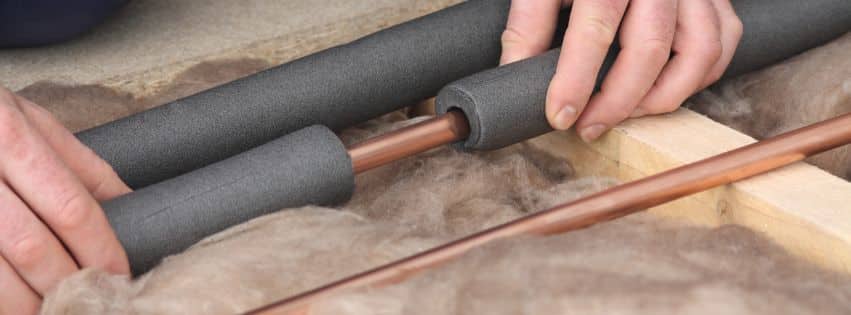
Preparing for Winter: Protect Your Outdoor Faucets from Freezing
The best way to prevent outdoor faucets and pipes from freezing is to shut off and drain exterior water lines, insulate vulnerable spots, and add protective covers before temperatures drop. A few hours of preparation in the fall can prevent thousands in plumbing repair bills during a Cleveland winter.
If you’ve lived through a Cleveland January, you know how unforgiving the cold can be. While the snow and ice may look beautiful outside, freezing temperatures put your plumbing system at serious risk. Outdoor faucets and pipes in unheated areas like garages or crawl spaces are often the first to freeze—and when they do, the result can be a burst line and water damage that spreads through your home.
The good news is that protecting your plumbing doesn’t have to be complicated or expensive. With the right steps taken before the first hard freeze, you can avoid that sinking feeling of turning on a faucet in February and hearing nothing. This guide explains exactly how to winterize your outdoor faucets and pipes, plus what to do when temperatures plunge.
Step 1: Shut Off and Drain Outdoor Faucets
The most effective way to keep an outdoor faucet from freezing is to stop water from sitting in the line altogether. In most homes, there’s a shut-off valve inside near the main water line or basement wall. Closing that valve, then opening the outdoor faucet to let any remaining water drain, relieves pressure in the line. Leaving the faucet cracked slightly open provides even more protection by giving ice room to expand without splitting the pipe.
If you don’t have a dedicated outdoor shut-off, it’s worth adding one. Plumbers can usually install them quickly, and they make every future winter much easier to handle.
Step 2: Add Outdoor Faucet Covers
Even after draining, faucets are still exposed to the cold air outside. Covering them adds a crucial buffer. Foam faucet covers are inexpensive and simple to use, while hard-shell insulated models provide stronger long-term protection. Some homeowners even make do with a towel wrapped around the spigot and sealed in a plastic bag. The important thing is that the cover fits tightly, with no air gaps where freezing winds can creep in.
If you want a quick and dependable solution, Lowe’s carries Frost King Outdoor Faucet Covers, which snap into place in seconds.
Step 3: Insulate Pipes in Vulnerable Areas
Outdoor faucets aren’t the only concern. Pipes that run through unheated spaces—garages, basements, crawl spaces, and attics—are equally at risk. Wrapping these lines in foam pipe sleeves slows heat loss dramatically, while self-regulating heat tape adds warmth in the coldest spots. In extremely drafty areas, fiberglass insulation can add another layer of security.
The process is straightforward: measure the length of pipe, cut insulation to size, and secure it with tape or zip ties so it won’t slip. Products like Frost King Foam Pipe Insulation make this a quick DIY task for homeowners.
Step 4: Disconnect and Store Garden Hoses
One of the simplest yet most overlooked winterizing steps is removing hoses from faucets. A hose left connected traps water inside, which can back up into the faucet and cause it to burst. Disconnecting hoses, draining them thoroughly, and storing them in a shed or basement keeps them from cracking and prevents plumbing damage.
If frozen hose bibs are a recurring issue for your home, you may want to upgrade to a frost-proof model. Lowe’s carries frost-proof hose bibs designed specifically for cold-weather regions, which allow residual water to drain out after each use.
Step 5: Keep Garages and Crawl Spaces Warm
If your pipes run through spaces exposed to outside air, such as a garage or crawl space, keeping those areas warmer makes a major difference. Close garage doors whenever possible, seal up noticeable cracks or gaps with caulk or insulation foam, and consider adding rigid foam panels around pipes that sit close to exterior walls.
On exceptionally cold nights, some homeowners set up a small electric heater near vulnerable pipes. If you take this route, make sure the heater is designed for safe, unattended operation.
Step 6: Let Faucets Drip in Extreme Cold
When temperatures plummet below 20°F, letting faucets drip is one of the simplest ways to prevent freezing. A slow trickle keeps water moving, and moving water resists ice formation. This is especially important for faucets along exterior walls or in homes with a history of freezing pipes. Don’t forget to let both the hot and cold sides drip, since either line can freeze under the right conditions.
Step 7: Maintain Steady Indoor Heat
Your home’s indoor temperature also affects exterior pipes. Keeping the thermostat set to at least 55°F—day and night—gives pipes the warmth they need to resist freezing. When leaving for vacation, avoid the temptation to turn the heat down too far. Opening cabinet doors under sinks allows warm air to circulate around pipes hidden inside walls.
For added peace of mind, many homeowners now use smart thermostats and Wi-Fi temperature sensors, available at Lowe’s, that send alerts when interior temperatures dip to dangerous levels.
Step 8: Be Ready to Shut Off Water in an Emergency
Despite your best efforts, pipes can still freeze and burst. Knowing where your main shut-off valve is—and how to use it—can make the difference between a small repair and major flood damage. Most valves are located in the basement or utility room. If yours requires a wrench, keep one nearby. Some homeowners are now choosing automatic shut-off systems that detect leaks and cut off water instantly.
FAQ: Common Questions About Frozen Pipes
How cold does it have to be for pipes to freeze?
Most pipes begin freezing when temperatures stay below 20°F, though poorly insulated pipes may freeze sooner, especially if exposed to wind.
Do faucet covers actually work?
Yes. While not a replacement for shutting off and draining lines, they add insulation that can prevent freezing during sudden cold snaps.
What happens if I forget to disconnect a hose?
Water trapped in the hose can freeze and back up into the faucet, often causing it to split. Always disconnect before the first hard frost.
Is dripping faucets wasteful?
It uses a small amount of water, but the cost is negligible compared to repairing a burst pipe and cleaning up water damage.
How do I know if a pipe is frozen?
The most obvious sign is no water flow. Frost on the outside of the pipe or odd sounds like gurgling can also indicate freezing inside.
Can I thaw a frozen pipe myself?
Yes, but do it carefully. A hair dryer or heat gun on low can safely thaw pipes. Never use an open flame, which can cause fires.
Do I need frost-proof hose bibs?
They aren’t mandatory, but in cold regions like Northeast Ohio, they’re a smart investment and reduce the need for seasonal prep.
What does it cost to repair a burst pipe?
Repairs can range from a few hundred to several thousand dollars depending on damage and cleanup. Prevention is always cheaper.
Should I turn off all water before traveling in winter?
If you’ll be gone for more than a couple of days, shutting off the main water supply is the safest option. Draining the system provides even better protection.




No Comments
Sorry, the comment form is closed at this time.